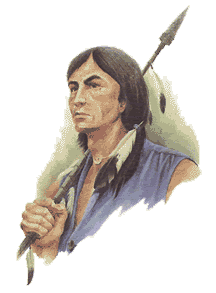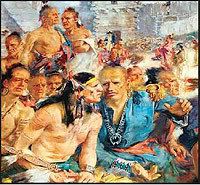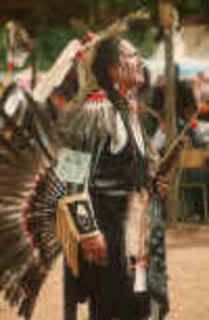

Blue Jacket or Weyapiersenwah (c. 1737 – c.1808)
was a war chief of the Shawnee people, known for his militant defense of Shawnee lands in the Ohio Country.
Perhaps the preeminent American Indian leader in the Northwest Indian War, in which a pan-tribal confederacy fought several battles with the United States, he was an important predecessor of the famous Shawnee leader Tecumseh.

Biography
Blue Jacket was a legendary Shawnee war chief. Since 1877, decades after his death, a famous story about him has circulated and been made popular by authors such as Allan Eckert, but also caused widespread debate.
Little is actually known of Blue Jacket's early life, which may be why there is so much confusion about his identity. According to the legend, a young man named Marmaduke Van Swearingen, wearing a blue coat, was captured and adopted by the Shawnee around the time of the American Revolutionary War. His younger brother, Charles, watched him being taken but was not taken himself. The legend also claims that years later, after earning the trust of the Shawnee and rising to the position of war chief, the white man, now viewing himself as an Indian, killed his brother in battle.
Despite the persistence of this tale, many questioned its authenticity. Academic historians, such as Blue Jacket biographer John Sugden and the late Francis Jennings, considered Eckert's books, which are billed as history, to be works of fiction. In 2000, DNA testing of the descendants of Blue Jacket and Van Swearingen gave additional support to the argument that Blue Jacket was not Van Swearingen. According to Sugden, nothing in the contemporary historical record indicated that Blue Jacket was anything other than a Shawnee Indian by birth.
George and James Bluejacket was the chief's two known sons. Blue Jacket's second wife, "Metis" Baby, left Ohio in 1843 for Kansas Territory with James Bluejacket and his family, but she died shortly after arriving at the Shawnee Kansas Reserve on the Kaw River.
(Information has been presented that conflicts with the the original reporting of this sentence. SCCPSS offers a special thanks to the Quannah Parker Historical Society for offering this correction.

(blue jacket dressed in blue)
Struggle for the Old Northwest
Blue Jacket participated in Dunmore's War and the American Revolutionary War (allied with the British), always attempting to maintain Shawnee land rights. With the British defeat in the American Revolutionary War, the Shawnee lost valuable assistance in defending the Ohio Country. The struggle continued as white settlement in Ohio escalated, and Blue Jacket was a prominent leader of the resistance.
On November 3, 1791, the army of a confederation of Indian tribes, led by Blue Jacket and Miami Chief Little Turtle (Michikinikwa), defeated an American expedition led by Arthur St. Clair, governor of the Northwest Territory. The battle, known as St. Clair's Defeat, was the crowning achievement of Blue Jacket's military career, and the most severe defeat ever inflicted upon the United States by Native Americans. Traditional accounts of the battle tend to give most of the credit for the victory to Little Turtle. John Sugden argues that Little Turtle's prominence is due in large measure to Little Turtle's self-promotion in later years.
Blue Jacket's triumph was short-lived. The Americans were alarmed by St. Clair's Defeat, and raised a new professional army, commanded by General Anthony Wayne. On August 20, 1794, Blue Jacket's confederate army clashed with Wayne at the Battle of Fallen Timbers, just south of present-day Toledo, Ohio. Blue Jacket's army was defeated, and he was compelled to sign the Treaty of Greenville on August 3, 1795, ceding much of present-day Ohio to the United States.
In 1805, Blue Jacket also signed the Treaty of Fort Industry, relinquishing even more of Ohio. In Blue Jacket's final years, he saw the rise to prominence of Tecumseh, who would take up the banner and make the final attempts to reclaim Shawnee lands in the Ohio Country.
Blue Jacket has Shawnee descendants to the present day.
Source
Sugden, John. Blue Jacket: Warrior of the Shawnees. University of Nebraska Press, 2000, ISBN 0-8030-4288.Sloat, Bill (Apr. 13, 2006)."Blue Jacket was Indian, not white, DNA shows". Cleveland Plain Dealer.
~~~~~~~~~~~~~~~~~~~~~~~~~
Bluejacket, an Outdoor Drama in Xenia, Ohio, Depicts the Life of Indian Shawnee Chief Bluejacket ...

Did you ever wish you could have lived in the 1800's?
Did you ever wish you could have seen a posse chasing a group of bank robbers?
Would you have like to have sight a fight between settlers and Indians?
Maybe you would have like to have seen the action--but from a safe distance? In Xenia, Ohio (about 10 miles west of Dayton, Ohio, and 50 miles north of Cincinnati), every year you can see an outdoor drama scheduled every year in the summer that depicts the struggle between the Shawnee Indian tribe and white settlers--Blue Jacket.
This is the 26th season for the play. If you attend a show you will get to see Native Americans ride thundering horses in the epic 2 ½ hour drama as the action comes to life in the outdoor Xenia, Ohio, drama. You will see the riders shoot flaming arrows on the outdoor stage.
The drama is about Shawnee Chief Blue Jacket and the Native Americans protecting their homelands in Ohio from encroaching frontiersmen. The play was written by W. L. Mundell and is based on the assumption that Chief Blue Jacket was originally a Dutchman named Marmaduke Van Swearingen who was taken by the Shawnees as a baby.
Some historians dispute that claim, however. Jo Anna Stevens, business development manager, said people should see the play, because everyone can learn from history. She said everyone learns something different by watching, and "it gives off such a wonderful feeling that makes you want to keep it with you forever.
" Chief Blue Jacket helped his men defeat U.S. frontier armies twice. The Shawnees participated in the battles 200 years ago. Tracy Leake, Chief of Operations for First Frontier, Incorporated, said the outdoor dram depicts an "epic" time in history. She added that the "theatre stands on land where most of the characters actually lived, fought, and died.
" She said that makes the play even more "beautiful" to watch. Even though there are some violent scenes in the outdoor drama in Xenia, the performers try to keep the scenes toned down, in consideration of children in attendance.
According to reports about the play, it contains something everyone will enjoy.
http://www.bluejacketdrama.com/





























No comments:
Post a Comment